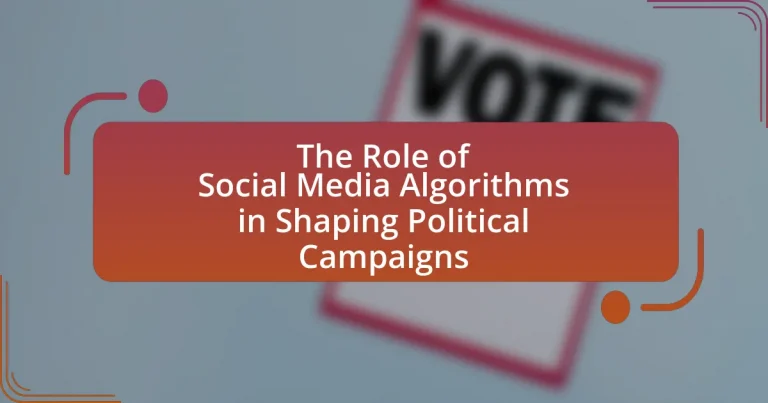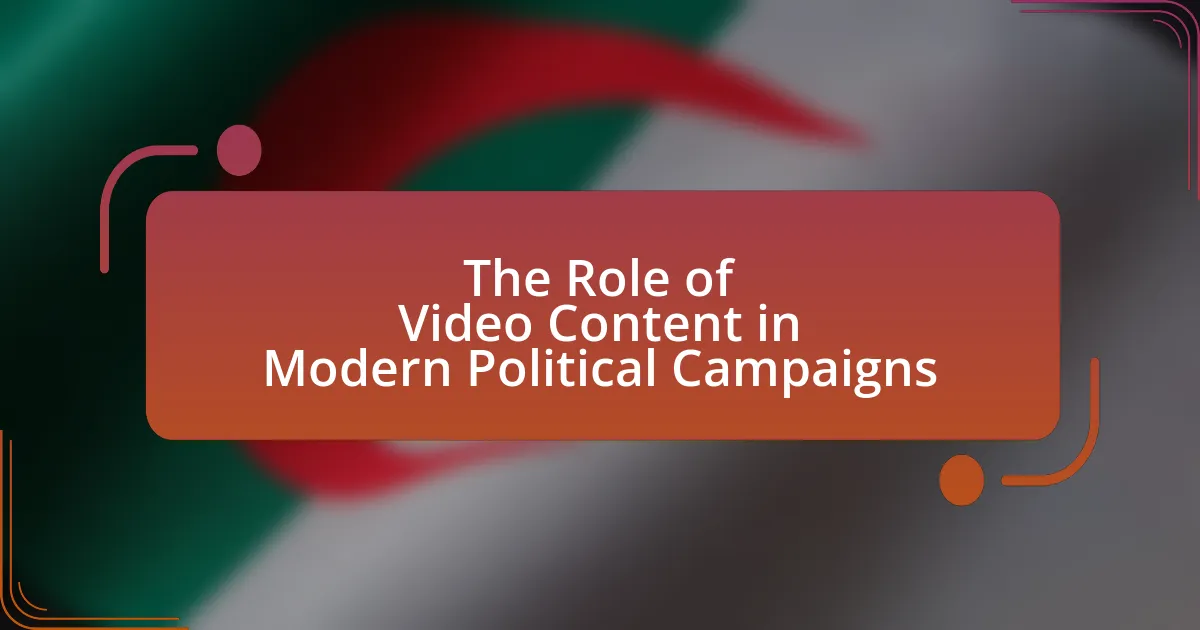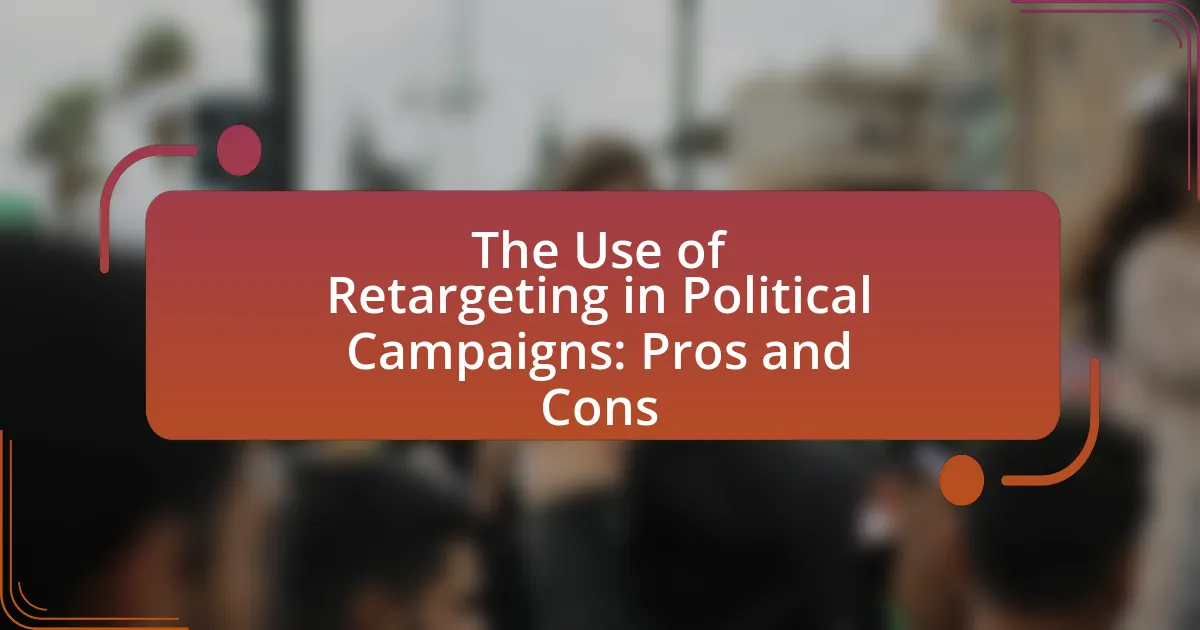Social media algorithms are pivotal in shaping political campaigns by influencing the visibility and reach of content shared by candidates and organizations. These algorithms analyze user behavior and preferences to curate personalized feeds, which can amplify certain political messages while suppressing others. The article explores how these algorithms affect voter behavior, facilitate targeted advertising, and impact the overall political landscape, highlighting both the advantages and challenges faced by campaigns in leveraging algorithm-driven strategies. Additionally, it addresses ethical concerns related to misinformation and privacy, as well as the implications of algorithm changes on political messaging and engagement.

What is the role of social media algorithms in shaping political campaigns?
Social media algorithms play a crucial role in shaping political campaigns by determining the visibility and reach of content shared by candidates and political organizations. These algorithms analyze user behavior, preferences, and interactions to curate personalized feeds, which can amplify certain messages while suppressing others. For instance, a study by the Pew Research Center found that 64% of Americans believe social media has a significant impact on their political views, highlighting the influence of algorithm-driven content on public opinion. Additionally, algorithms can facilitate targeted advertising, allowing campaigns to reach specific demographics effectively, as evidenced by the 2016 U.S. presidential election, where targeted ads on platforms like Facebook were pivotal in influencing voter behavior.
How do social media algorithms influence voter behavior?
Social media algorithms significantly influence voter behavior by curating content that aligns with users’ preferences and beliefs, thereby shaping their political opinions. These algorithms prioritize engagement, often amplifying polarizing content that resonates with users, which can lead to echo chambers where individuals are exposed primarily to viewpoints that reinforce their existing beliefs. Research indicates that algorithm-driven content can sway undecided voters; for instance, a study by the Pew Research Center found that 64% of Americans believe social media has a significant impact on their political views. This targeted exposure can mobilize voters by increasing political awareness and engagement, ultimately affecting election outcomes.
What mechanisms do algorithms use to target political content?
Algorithms use data-driven mechanisms such as user profiling, engagement metrics, and content recommendation systems to target political content. User profiling involves analyzing demographic information, interests, and online behavior to tailor political messages to specific audiences. Engagement metrics, including likes, shares, and comments, help algorithms prioritize content that resonates with users, thereby increasing visibility for political posts. Content recommendation systems utilize machine learning to suggest political content based on users’ past interactions, ensuring that relevant political messages reach the intended audience effectively. These mechanisms have been evidenced by studies showing that targeted political ads can significantly influence voter behavior and engagement during elections.
How do algorithms affect the visibility of political messages?
Algorithms significantly influence the visibility of political messages by determining which content is prioritized in users’ feeds. These algorithms analyze user behavior, engagement patterns, and preferences to curate content that aligns with individual interests, often amplifying messages that resonate with specific demographics. For instance, a study by the Pew Research Center found that 64% of Americans believe social media platforms have a significant impact on the political landscape, highlighting the role of algorithms in shaping public discourse. Consequently, political messages that align with trending topics or user interests are more likely to be seen and shared, while dissenting or less popular views may be marginalized, affecting overall political engagement and awareness.
Why are social media algorithms critical in modern political campaigns?
Social media algorithms are critical in modern political campaigns because they determine the visibility and reach of political content to targeted audiences. These algorithms analyze user behavior, preferences, and interactions to curate personalized feeds, which can significantly influence voter perceptions and engagement. For instance, a study by the Pew Research Center found that 62% of Americans get their news from social media, highlighting the platforms’ role in shaping public opinion. Additionally, campaigns leverage these algorithms to optimize ad placements and messaging, ensuring that their content resonates with specific demographics, thereby enhancing voter mobilization efforts.
What advantages do political campaigns gain from using algorithms?
Political campaigns gain several advantages from using algorithms, primarily enhanced targeting, data analysis, and efficiency in resource allocation. Algorithms enable campaigns to analyze vast amounts of voter data, allowing for precise segmentation of the electorate based on demographics, interests, and behaviors. This targeted approach increases the likelihood of engaging potential voters effectively. For instance, a study by the Pew Research Center found that tailored messaging can significantly improve voter turnout by addressing specific concerns relevant to different voter groups. Additionally, algorithms facilitate real-time performance tracking of campaign strategies, enabling quick adjustments based on data-driven insights, which optimizes campaign efforts and maximizes impact.
How do algorithms help in mobilizing supporters?
Algorithms help in mobilizing supporters by analyzing user data to identify and target individuals most likely to engage with a campaign. These algorithms assess patterns in user behavior, preferences, and interactions, allowing campaigns to tailor their messaging and outreach strategies effectively. For instance, a study by the Pew Research Center found that 69% of adults in the U.S. use social media, making it a crucial platform for political engagement. By leveraging algorithms, campaigns can optimize their content delivery, ensuring that supporters receive relevant information at the right time, which increases the likelihood of mobilization and participation in events or actions.
What challenges do political campaigns face with social media algorithms?
Political campaigns face significant challenges with social media algorithms, primarily due to the lack of transparency and unpredictability in how content is prioritized. These algorithms often favor engagement metrics, which can lead to the amplification of sensational or polarizing content over more substantive political discourse. For instance, a study by the Pew Research Center found that 64% of Americans believe social media has a mostly negative effect on the way things are going in the country today, indicating a public perception that algorithms may distort political communication. Additionally, campaigns struggle with algorithm changes that can suddenly alter their reach and effectiveness, making it difficult to maintain consistent messaging. This unpredictability can hinder strategic planning and resource allocation, ultimately impacting voter outreach and engagement.
How can misinformation spread through algorithmic amplification?
Misinformation can spread through algorithmic amplification by prioritizing content that generates high engagement, regardless of its accuracy. Social media platforms utilize algorithms that analyze user interactions, such as likes, shares, and comments, to promote posts that are likely to capture attention. This often leads to sensational or misleading information being amplified, as it tends to provoke stronger emotional responses, thereby increasing user engagement. Research by the Massachusetts Institute of Technology found that false news stories are 70% more likely to be retweeted than true stories, highlighting the effectiveness of algorithmic amplification in spreading misinformation.
What ethical concerns arise from algorithm-driven political advertising?
Algorithm-driven political advertising raises significant ethical concerns, primarily related to misinformation, manipulation, and privacy violations. Misinformation can spread rapidly through targeted ads, leading to the dissemination of false narratives that can mislead voters. For instance, during the 2016 U.S. presidential election, social media platforms were criticized for allowing the spread of fake news, which influenced public opinion and voter behavior.
Manipulation occurs when algorithms exploit user data to create highly personalized ads that can sway opinions without users being aware of the influence. This raises questions about the fairness of democratic processes, as certain demographics may be targeted with specific messages that reinforce biases or fears.
Privacy violations are another critical concern, as political advertisers often collect extensive personal data to tailor their messages. This practice can infringe on individuals’ rights to control their own information, leading to a lack of transparency about how data is used and who is being targeted. The Cambridge Analytica scandal exemplifies this issue, where data from millions of Facebook users was harvested without consent for political advertising purposes.
These ethical concerns highlight the need for regulatory frameworks to ensure accountability and protect democratic integrity in the context of algorithm-driven political advertising.
How do social media algorithms interact with traditional campaign strategies?
Social media algorithms significantly enhance traditional campaign strategies by optimizing audience targeting and engagement. These algorithms analyze user behavior, preferences, and interactions to deliver tailored content, which allows campaigns to reach specific demographics more effectively than traditional methods alone. For instance, a study by the Pew Research Center found that 69% of adults in the U.S. use social media, making it a crucial platform for political outreach. By integrating social media insights, campaigns can adjust their messaging in real-time based on audience reactions, thereby increasing the likelihood of voter mobilization and support.
What are the implications of algorithm changes on political messaging?
Algorithm changes significantly impact political messaging by altering the visibility and reach of content. For instance, when social media platforms modify their algorithms to prioritize certain types of engagement, such as likes or shares, political messages that resonate with these metrics gain more exposure. This can lead to a shift in public discourse, as messages that are sensational or emotionally charged may be favored over more nuanced or factual content. A study by the Pew Research Center found that algorithm-driven content can create echo chambers, where users are predominantly exposed to information that aligns with their existing beliefs, thereby reinforcing polarization. Consequently, political campaigns must adapt their strategies to align with these algorithmic preferences, often prioritizing viral content over substantive policy discussions.
What specific strategies can political campaigns employ to optimize algorithm use?
Political campaigns can optimize algorithm use by employing targeted advertising, data analytics, and content personalization. Targeted advertising allows campaigns to reach specific demographics based on user data, increasing engagement and conversion rates. For instance, Facebook’s advertising platform enables campaigns to target users by age, location, and interests, which can lead to higher effectiveness in reaching potential voters.
Data analytics plays a crucial role in understanding voter behavior and preferences, allowing campaigns to refine their strategies based on real-time feedback and engagement metrics. Campaigns can analyze which types of content resonate most with their audience, enabling them to adjust their messaging accordingly.
Content personalization enhances user experience by delivering tailored messages that align with individual interests and values. This approach can significantly improve user interaction and shareability, as personalized content is more likely to be engaged with and shared across social media platforms.
These strategies are supported by evidence showing that campaigns utilizing data-driven approaches and personalized content have seen increased voter engagement and support, as demonstrated in various electoral studies.
How can campaigns effectively analyze algorithmic data?
Campaigns can effectively analyze algorithmic data by employing advanced analytics tools that interpret user engagement metrics and content performance. These tools utilize machine learning algorithms to identify patterns in user behavior, allowing campaigns to tailor their strategies based on real-time feedback. For instance, a study by the Pew Research Center found that 69% of adults in the U.S. use social media, highlighting the importance of understanding how algorithms influence user interactions. By analyzing data such as click-through rates, shares, and comments, campaigns can optimize their messaging and target specific demographics more efficiently, ultimately enhancing voter outreach and engagement.
What best practices should campaigns follow to enhance engagement through algorithms?
Campaigns should prioritize data-driven content strategies to enhance engagement through algorithms. By analyzing audience behavior and preferences, campaigns can tailor their messaging to resonate with specific demographics, thereby increasing interaction rates. For instance, utilizing A/B testing allows campaigns to identify which types of content—such as videos, images, or text—generate the most engagement, leading to optimized content delivery. Additionally, leveraging user-generated content can foster community involvement and enhance algorithmic visibility, as platforms often prioritize authentic interactions. Research indicates that posts with higher engagement rates are favored by algorithms, resulting in increased reach and visibility. Therefore, implementing these best practices can significantly improve a campaign’s effectiveness in engaging audiences through social media algorithms.




